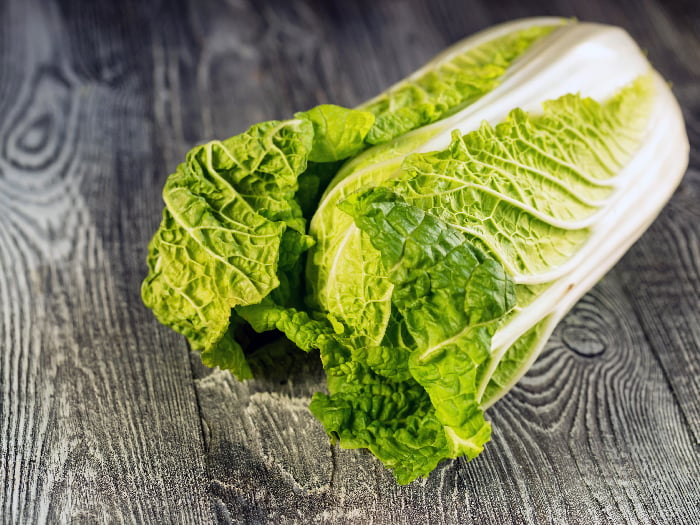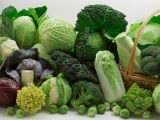You may not like your greens but napa cabbage makes it difficult to do so. This beautiful, frilly-looking cabbage has a sweet, mellow taste and crisp texture. This is what makes it delicious and addictive as Korean kimchi or wonderfully tender in a hot, spicy broth.
What is Napa Cabbage?
Napa cabbage, also known as Chinese or celery cabbage, is an oblong-shaped vegetable with thick white ribs and light green leaves. It is milder and sweeter in taste than regular green cabbage. The outer green leaves are slightly tough and are used as wraps for pork, chicken, or oysters. The inner leaves are used as a filling for dim sums or used in broths. These leaves quickly absorb the flavor of the broth, making them a delicious addition to hot pots or soups. In Korea, 90 percent of Chinese cabbage is used to make kimchi, a fermented dish, that has become popular all over the world. [1]
Napa cabbage (Brassica rapa Pekinensis) may have originated in Beijing, China as a natural hybridization between a turnip and bok choy. While it is widely used in Asia, it has spread to Europe, the Americas, and Australia. [2]

Napa cabbage, also known as Chinese cabbage, is rich in vitamin C. Photo Credit: Shutterstock
Nutrition
Napa cabbage is an extremely low-calorie vegetable. One cup of cooked napa (109 g) is only 13 calories, with 2.4 grams of carbohydrates, according to the USDA FoodData Central. It is rich in vitamin K and vitamin C. It also contains manganese, calcium, folate, and magnesium. [3]
Serving Size : Nutrient Value Water [g] 96.33 Energy 12 Energy [kJ] 50 Protein [g] 1.1 Total lipid (fat) [g] 0.17 Ash [g] 0.17 Carbohydrate, by difference [g] 2.23 Calcium, Ca [mg] 29 Iron, Fe [mg] 0.74 Magnesium, Mg [mg] 8 Phosphorus, P [mg] 19 Potassium, K [mg] 87 Sodium, Na [mg] 11 Zinc, Zn [mg] 0.14 Copper, Cu [mg] 0.1 Manganese, Mn [mg] 0.2 Selenium, Se [µg] 0.4 Vitamin C, total ascorbic acid [mg] 3.2 Thiamin [mg] 0.01 Riboflavin [mg] 0.03 Niacin [mg] 0.47 Pantothenic acid [mg] 0.04 Vitamin B-6 [mg] 0.04 Folate, total [µg] 43 Folate, food [µg] 43 Folate, DFE [µg] 43 Vitamin A, RAE [µg] 13 Carotene, beta [µg] 133 Carotene, alpha [µg] 49 Vitamin A, IU [IU] 263 Sources include : USDA [4]
How To Buy, Cut, & Cook Napa Cabbage?
Here are some tips to help you shop for and prepare napa cabbage.
Buy & Store
When buying napa cabbage, select one that has bright white ribs and firm green leaves. It should also feel heavy. It is best to use the Chinese leaves in the first two or three days to enjoy its crispness. However, it can stay in the refrigerator for longer if you cover it with cling wrap. In case you see black spots on the cabbage, you do not necessarily have to discard it. Mostly, the black spots are on the outer leaves and you can discard those. Use the inner leaves after checking it thoroughly. [5]
How to Cut Napa Cabbage?
Let’s look at a 3-step method to clean and cut napa.
- Cut the hard bottom of the cabbage.
- You can either choose to cut it lengthwise into half or you can choose to peel away the cabbage leaves.
- Slice into shreds, as thick or thin you need it. Wash it well in a colander. It is now ready to be cooked!
How to Cook Napa Cabbage?
If you are wondering what to do with napa cabbage, here are some of the easiest ways to use it.
- Soup: You can add shredded napa leaves to any soup of your choice, including chicken, beef, or Chinese vegetable tofu soup. Try adding it to our Simple Miso Soup – this is a soul-filled comforting choice for a weeknight dinner.
- Kimchi: This is a popular Korean fermented dish and it can be quite addictive. Here’s our Easy-To-Make Kimchi recipe, along with information on its nutritional benefits.
- Stir-fry: Shredded cabbage tastes delicious in a stir-fry like this recipe – Stir Fry With Avocado & Egg. Add the white parts early on in the stir-fry as they require more cooking time than the green parts.
- Stuffed: You can blanch whole napa leaves in salted hot water to let them wilt. These leaves are the perfect low-carb wrap for spiced rice, beans, chicken, or shredded spiced vegetables.
- Slaw or salads: You can substitute napa for regular cabbage to make a delicious slaw. While shredded napa leaves taste wonderful in an Asian-style salad, you can use them in simple green salads too.
- Spring roll or dim sum filling: You can make a delicious filling with chopped ginger, napa leaves, mushrooms, julienned carrots, and scallions. Add minced pork, chicken, or tofu depending on your preferences. Cook till soft and use it as a filling for spring rolls or dim sums.
Substitutes for Chinese Cabbage
If you cannot source a crisp napa or would like an alternative, you can use bok choy or green cabbage. They have a similar crisp texture. Napa has the mildest flavor, with bok choy coming second, and cabbage having the strongest leaf-life flavor. In terms of cooking time, napa cooks much quicker than bok choy or cabbage. The cabbage will the longest to cook.

